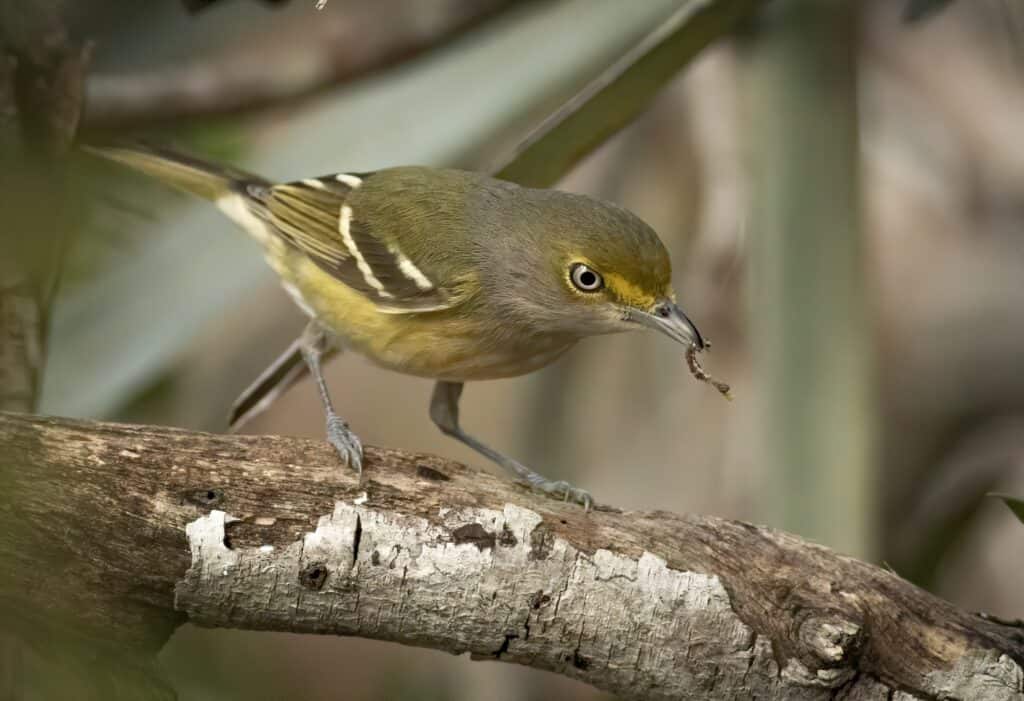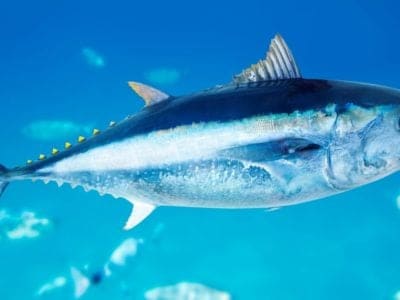White-Eyed Vireo
Vireo griseus
During courtship, males put on exciting displays by fluffing their plumage, spreading their tails, and letting out a whining call.
Advertisement
White-Eyed Vireo Scientific Classification
- Kingdom
- Animalia
- Phylum
- Chordata
- Class
- Aves
- Order
- Passeriformes
- Family
- Vireonidae
- Genus
- Vireo
- Scientific Name
- Vireo griseus
Read our Complete Guide to Classification of Animals.
White-Eyed Vireo Conservation Status
White-Eyed Vireo Facts
- Prey
- Insects
- Name Of Young
- Chicks
- Group Behavior
- Solitary/Pairs
- Fun Fact
- During courtship, males put on exciting displays by fluffing their plumage, spreading their tails, and letting out a whining call.
- Estimated Population Size
- 24 million
- Biggest Threat
- Habitat loss
- Most Distinctive Feature
- Their yellowish -green plumage
- Wingspan
- 7.4 inches
- Incubation Period
- 13 to 15 days
- Age Of Independence
- 23 days
- Age Of Fledgling
- 9 to 11 days
- Habitat
- Dense, brushy vegetation close to a water source
- Diet for this Fish
- Omnivore
- Lifestyle
- Diurnal
- Favorite Food
- Insects
- Common Name
- White-eyed vireo
- Number Of Species
- 59
- Location
- North and Central America
- Migratory
- 1
View all of the White-Eyed Vireo images!
Vireo griseus, or the white-eyed vireo, are small birds belonging to the Vireonidae family and Passeriformes order. This family contains 60 species of birds!
They derived their name because of their white eyes and inhabit several states in North America like Missouri, New Jersey, Florida, and Texas. In addition, they occur in the Bahamas and Cuba.
White-eyed vireos like habitats with dense shrubs and bushes, preferably in an abandoned field. In addition, they are a year-round resident in many countries across South America. They have a greenish tinge that blends in well with their surroundings, providing them with the essential camouflage they need.
Their mating season begins in April and lasts till August. These birds are monogamous, and both genders build nests and incubate the eggs. Once the eggs hatch, males and females feed the young for several days.
Their plumage is yellowish-gray, and they have yellow sides with white bellies. In addition, they have a black beak and legs. Their song consists of six to seven short phrase calls, generally used by the male to attract a mate during the breeding season. However, chicks also use this call.
Three Incredible White-Eyed Vireo Facts!
- The white-eyed vireo is unique because they are one of two species of North American passerines with white eyes. However, another bird with the same characteristic, the Wrentit, is also found in dense shrubbery or bushes but occurs along Northern Mexico and the West Coast.
- White-eyed vireos are great mimickers and often copy the songs of other birds species within their habitat. In fact, they incorporate them into their own songs. Interestingly, males are the only ones that sing during mating season. However, both genders sing in the winter.
- Unfortunately, like many other birds, the white-eyed vireo is the victim of the Brown-headed cowbirds’ parasitic nature. Cowbirds lay their eggs in other birds’ nests and leave the rearing to the host parents. Often these hatchlings outcompete the vireos chicks, which land up starving or pushed from the nest.
Where to Find the White-Eyed Vireo
White-eyed vireos are native to North America and Central America. They are Neotropical migrants that participate in seasonal migrations multiple times a year.
However, they inhabit the southeastern United States and Northern Mexico during mating season. This distribution occurs over states like:
These birds are year-round residents along the southeast coastline of the USA from Texas to South Carolina and Mexico.
However, during the colder months, most populations will migrate to Belize, Mexico, Cuba, Guatemala, the Cayman Islands, and the Bahamas.
They like to inhabit dense, brushy vegetation close to a water source.
Nests
In order to defend their nesting territory, white-eyed vireo males sing incessantly from early spring to late summer.
During courtship, males put on exciting displays by fluffing their plumage, spreading their tails, and letting out a whining call. Then, both genders help to build the nest, which they construct low to the ground in a shrub or sapling.
They will weave the rim onto a horizontal forked twig to ensure the nest is secure. The nest is deep and hangs in the shape of a cup. White-eyed vireos make their nest from roots, shreds of bark, twigs, grass stems, leaves, plant down, moss, lichen, and sometimes pieces of wasp nests. They construct their nests with spiderwebs, which help bind them and line them with fine grass, feathers, and fibers.
White-Eyed Vireo Scientific Name
The white-eyed vireo’s scientific name is Vireo griseus, and they belong to the order Passeriformes. The members of this order make up more than half of the entire bird species!
Their most distinguishable feature is the arrangement of their toes, with three pointing forwards and one pointing back, this aids with perching.
White-eyed vireos are members of the Vireonidae family, which consists of 43 species of small arboreal songbirds, divided between four genera. The relationships of this family with other bird families are not entirely clear, but evidence suggests that they are closely related to the New World warblers.
The family Vireonidae is divided into three subfamilies:
- The Vireoninae – consists of Greenlets (Hylophilus) and True Vireos (genus Vireo)
- Cyclarhidinae
- Vireolaniinae
White-Eyed Vireo Size and Appearance
White-eyed vireos are small birds that measure 5 inches in length and have a wingspan of around 7.4 inches. In addition, adults weigh approximately 0.40 ounces. Their sides are dark olive, and they have black wings and tails. Each wing sports two white wing bars with white or yellow margins on the primaries.
Their heads are olive, and they possess a gray nape. However, their most distinctive feature is their illuminating yellow spectacles, which include the area between and around the eyes. Another identifying feature is their white irises, only visible in adults.
In addition, they have white bellies and throats and dull yellow sides. Their legs and beaks are a dark black color. Juveniles have dark black irises that only change color when they reach 2 years old.
Juveniles differ from adults in more than one way; instead of yellow spectacles, they have white, and their heads are pale gray. In addition, their plumage is paler in comparison to their parents. However, unlike most bird species, both genders look similar.

White-eyed vireo are omnivorous and eat insects, snails, and lizards as well as berries.
©Matthew Jolley/Shutterstock.com
White-Eyed Vireo Migration Pattern and Timing
During the mating season, white-eyed vireos spread throughout eastern Texas and travel as far north as southeastern Iowa and Illinois. In addition, they expand as far as southern Ontario, Maryland, and Connecticut in the east.
However, in the winter months, white-eyed vireos occupy southern territories in Mexico, and Central America, as far as Honduras. Other winter locations include Bermuda, the Caribbean, the Bahamas, and Cuba.
Sometimes these birds get lost while migrating and land up much further west or north than they typically expected.
White-Eyed Vireo Behavior
White-eyed vireos are typically solitary but sometimes live in pairs. During their fall migration, it is common for these birds to join mixed foraging flocks containing other species.
In order to stay well-hidden, they tend to inhabit lower thickets, which makes it difficult to see their coloration properly. However, their white eyes and yellow spectacles stick out and act as good field marks, even when visuals are obscured.
White-Eyed Vireo Diet
These birds prey primarily on insects and enjoy a range of insects, including spiders and larvae. Sometimes, if there is a food shortage, white-eyed vireos also eat snails and small lizards. In addition, they feed on berries and other fruits.
White-Eyed Vireo Reproduction and Lifespan
White-eyed vireos are monogamous, and females will visit the males’ territories to choose a mate. The males don’t participate in any sensational courtship displays. However, the pair will court each other for several days, where they will forage together.
While these birds are monogamous, they do not mate for life. Surprisingly, they only stay together for one season. The mating season ranges from early April to August, and after pairing up, both genders search for a nesting site.
They build their nest off the ground, usually around 3 feet from the surface. Females seek out a comfortable nesting site with a forked branch for support. White-eyed vireos build their nests in a cup shape and construct them with grass, spider silk, twigs, and bark strips.
It takes the pair around 3 to 5 days to build the nest and once done, the female lays 3 to 5 white eggs with dark spots. Then, the male and female white-eyed vireos incubate the eggs for around 13 to 15 days.
Once hatched, the juveniles leave the nest within 9 to 11 days. However, before they go, both parents share the responsibility of caring for them. As a result, fledglings sometimes depend on their parents for 23 days after leaving the nest.
Chicks hatch blind and naked with a few down patches here and there. White-eyed vireos have a unique characteristic; parents develop a brood patch on their bellies, providing the eggs with extra warmth.
Lifespan
White-eyed vireos have an average lifespan of 10 years.
Predators, Threats, and Conservation Status
The predators that prey on white-eyed vireos have rarely been documented, as most predation occurs during the mating season when eggs and hatchlings are abundant. However, it is likely these birds fall prey to :
The white-eyed vireo’s numbers are increasing year by year because of their large geographical range and population size, and they are listed as Least Concern on IUCN’s Redlist.
However, their numbers could start decreasing because of habitat loss and extensive human activity in their natural habitats.
Population
The white-eyed vireo population is increasing, and their population size is estimated at 24 million individuals.
Species Similar to the White-Eyed Vireo
There are approximately 60 species of vireos in the world, and while they have similar characteristics, these species differ in some way, shape, or form. Below are four of the most popular species.
1. Yellow-Throated Vireo
The yellow-throated vireo is native to parts of eastern North America. They are the most vivacious of the vireo family with their bright yellow and olive-gray plumage.
These birds migrate south during winter, primarily to Central America and northern South America. They can become fiercly territorial during winter, especially with members of the same species.
They prefer to inhabit deciduous forests and endure human presence. In addition, they can be found in habitats like beaches, shrubs, plantations, and cypress swamps.
Yellow-throated vireos are foragers and often fly with mixed flocks, especially when migrating. They let out harsh and scolding calls, and their songs are broken and burry-like.
They are very protective of their nests, which are usually built high in trees. Currently, their population is
2. Bell’s Vireo
These birds have one of the most purest chirps forming songs that vibrate in the atmosphere. Bell’s vireos are native to North and Central America. Bell’s vireos are small neotropical migratory birds that grow to lengths of 4.5 to 4.9 inches and weigh between 0.2 to 0.3 ounces. They primarily feed on ground and aerial insects.
Bell’s vireos have olive-yellow plumage with a tinge of gray. However, their subspecies, the least Bell’s vireo, is mostly gray. Their beaks and legs are dark brown, and they have medium-sized tails.
In addition, these birds have a wingspan of 6.7 to 7.5 inches. Bell’s vireos are not endangered and are listed as Least Concern on IUCN’s redlist.
3. Thick-Billed Vireo
Thick-billed vireos are medium-sized birds, approximately 5.5 inches in length. They have greyish olive heads and backs, pale yellow or buffy white underparts, and their undertails are shaded white.
In addition, their wings and tails are dark, and they have two white wing bars on each wing. Thick-billed vireos have dark irises, unlike their cousins, the white-eyed vireo, and their bills are large and gray. Lastly, both sexes look alike.
Breeding males occur in southeastern Florida and the Florida Keys. In addition, they are common in the Caribbean, where their preferred habitats include dense undergrowth and thickets.
4. Blue-Headed Vireo
The blue-headed vireo has a pleasing palette of bluish gray, moss green, and greenish-yellow, which is complimented by their bold white spectacles, throat, and belly. In addition, they have sharp black wings and tails
Like their cousins, the blue-headed vireo forages for larvae and insects in trees, moving swiftly through branches inaccessible by most other bird species. Males below out a slow and happy chorale, which is the first thing to listen for when searching for one.
During the warmer months, Blue-headed vireos forage in the canopy of mature forests. They are often heard singing, which helps them distinguish their calls from Philadelphia, yellow-throated, and red-eyed vireos.
What’s Up Next?
View all 109 animals that start with WWhite-Eyed Vireo FAQs (Frequently Asked Questions)
Where do White-eyed vireos live?
White-eyed vireos are native to North and Central America. They are Neotropical migrants that participate in seasonal migrations multiple times a year.
How big are white-eyed vireos?
White-eyed vireos are small birds that measure 5 inches in length and have a wingspan of around 7.4 inches. In addition, adults weigh approximately 0.40 ounces.
What color are white-eyed vireos?
Their sides are dark olive, and they have black wings and tails. Each wing sports two white wing bars with white or yellow margins on the primaries. Their heads are olive, and they possess a gray nape. However, their most distinctive feature is their illuminating yellow spectacles, which include the area between and around the eyes. Another identifying feature is their white irises, only visible in adults.
Thank you for reading! Have some feedback for us? Contact the AZ Animals editorial team.
Sources
- The Spruce / Accessed August 29, 2022
- All About Birds / Accessed August 29, 2022
- Audubon / Accessed August 29, 2022
- Wikipedia / Accessed August 29, 2022
- Kidadl / Accessed August 29, 2022
- ABC Birds / Accessed August 29, 2022















